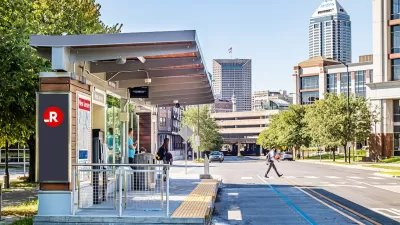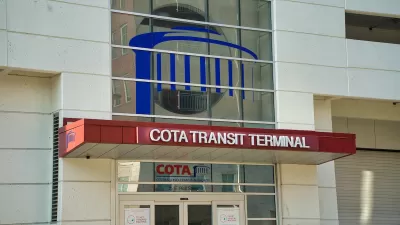Despite being the nation’s 14th largest city, Columbus, Ohio has no high-capacity transit. That could change this November as city officials put a levy before voters that would provide $6.2 billion by 2050 to fund an ambitious bus rapid transit system.

“You'd think with a nickname like ‘Cbus,’ the city would have state-of-the-art public transportation,” begins an article by Columbus Dispatch investigative reporter Jordan Laird. But the truth is, despite being the nation’s 14th largest city, it is the most populous in America without high-capacity transit. The city is served only by Central Ohio Transit Authority buses, which come so infrequently it can take hours to get across the city. City leaders are looking to change that. “Local officials want to catch up to other cities — not by train as local transit enthusiasts have long asked — but by bus. A proposed bus system overhaul could improve service and focus residential and business growth along high-speed bus lines, according to proponents,” Laird reports, and they’re putting it to voters on the November 5 ballot in the form of a levy that would raise COTA’s share of local sales tax from a half-percent to 1 percent and bring in an estimated $6.2 billion by 2050.
The plan, called LinkUS, has been several years in the works. It would build three COTA rapid transit bus lines by 2030, with at least another two planned for later dates. “In addition, LinkUS would also fund 45% more regular bus service; expand a COTA program for cheap rideshare options similar to Uber; and pay to build more than 500 miles of bike paths, sidewalks and trails across Franklin County by 2050.” The move comes as, like many cities across the U.S., bus ridership remains low after the pandemic; “COTA gave 11.12 million rides in 2023, compared to 19.4 million in 2019,” Laird reports. But the city has grown rapidly over the past two decades and that’s anticipated to continue. City officials see it as a preventative measure to rising housing costs and a way to concentrate growth along specific corridors.
The Dispatch article goes into detail about the proposed routes, the deliverables for the BRT plan, service frequency, and more, as well as the city’s reasoning behind choosing BRT and not light rail.
FULL STORY: What to know about COTA levy: Columbus wants to catch up to other cities with rapid bus lines

Study: Maui’s Plan to Convert Vacation Rentals to Long-Term Housing Could Cause Nearly $1 Billion Economic Loss
The plan would reduce visitor accommodation by 25,% resulting in 1,900 jobs lost.

North Texas Transit Leaders Tout Benefits of TOD for Growing Region
At a summit focused on transit-oriented development, policymakers discussed how North Texas’ expanded light rail system can serve as a tool for economic growth.

Why Should We Subsidize Public Transportation?
Many public transit agencies face financial stress due to rising costs, declining fare revenue, and declining subsidies. Transit advocates must provide a strong business case for increasing public transit funding.

How to Make US Trains Faster
Changes to boarding platforms and a switch to electric trains could improve U.S. passenger rail service without the added cost of high-speed rail.

Columbia’s Revitalized ‘Loop’ Is a Hub for Local Entrepreneurs
A focus on small businesses is helping a commercial corridor in Columbia, Missouri thrive.

Invasive Insect Threatens Minnesota’s Ash Forests
The Emerald Ash Borer is a rapidly spreading invasive pest threatening Minnesota’s ash trees, and homeowners are encouraged to plant diverse replacement species, avoid moving ash firewood, and monitor for signs of infestation.
Urban Design for Planners 1: Software Tools
This six-course series explores essential urban design concepts using open source software and equips planners with the tools they need to participate fully in the urban design process.
Planning for Universal Design
Learn the tools for implementing Universal Design in planning regulations.
Ascent Environmental
Borough of Carlisle
Institute for Housing and Urban Development Studies (IHS)
City of Grandview
Harvard GSD Executive Education
Toledo-Lucas County Plan Commissions
Salt Lake City
NYU Wagner Graduate School of Public Service





























